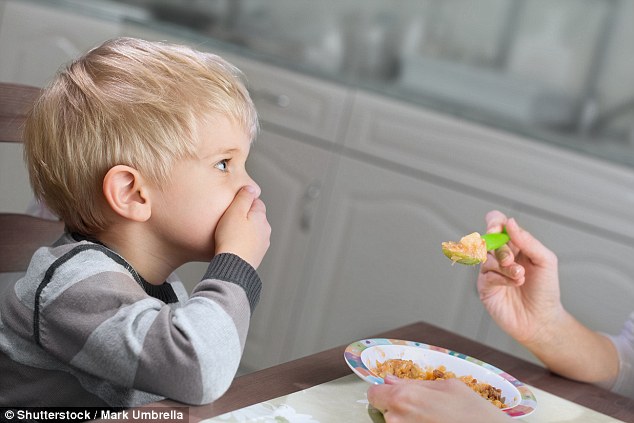Children who are extreme picky eaters may have an eating disorder that puts them at a higher risk for depression and anxiety.
A child who is underweight, eats less than 20 types of foods and gets anxious around food may suffer from avoidant restrictive food intake disorder (ARFID), the second most common eating disorder in children under 12.
The anxiety and fear ARFID sufferers experience around new food can cause social limitations, such as the inability to eat at a friend’s house or go to a birthday dinner, which can lead to depression and other eating disorders.
A registered nutritionist revealed to Daily Mail Online her method for combating picky eaters in a program she runs called Picky Eater Rehab.
Connecticut-based registered nutritionist Jill Castle, 50, has transformed over 30 kids who refused to eat anything except chicken nuggets and processed food into pasta and vegetable lovers.
Picky eating is most common in children aged two through six – when kids are becoming more independent and start resisting food.
During these years it is especially important for parents not to give in or cater to a child’s picky eating habits, but rather let kids get used to the family diet, according to Jill.
After six years old health problems such as nutrient deficiencies or poor growth are likely if a child has cut entire food groups out of their diet and are only eat less than 20 different foods.
Although many children go through phases of picky eating, a person with ARFID does not consume enough calories to grow and develop properly and if carried into adulthood, it is difficult to maintain basic body functions.
This disorder goes beyond being selective with food.
ARFID can be caused by a bad experience with food. For example, a child may have choked or felt sick after eating something and refuses to eat it again.
Other children may have heightened senses, meaning that the texture, smell or flavor is off-putting.
ARFID is a newly recognized disorder that affects about 14 percent of children and more commonly boys.
A study found that nearly half of children with ARFID report fear of vomiting or choking, and one-fifth said they avoid certain foods because of sensory issues.
One-third of children with ARFID have a mood disorder and nearly 20 percent have an autism spectrum condition, according to research.
When extreme picky eating disrupts social interactions due to difficulties eating with others, a child is at a higher risk for developing anxiety disorders and depression.
Jill follows steps throughout her Picky Eater Rehab and works with parents and their children to kick their poor eating habit.
The process could take more than a year with sessions every two weeks.
‘The goal is to build confidence in the child that they can try any food and nothing bad will happen to them,’ she said.
1. Stop picky eating in its tracks
Parents should look for the signs of a picky eater early on to combat poor eating habits at their inception.
Picky eating is common in children aged two to six so they may reject food that they previously liked but then eventually add it back into their diet, according to Jill.
However, if after six years old a child has cut entire food groups from their diet, it is important to reintroduce foods before they develop more severe symptoms of ARFID.
It is much simpler to get children to try different foods at a younger age than it is once they’ve formed a strong opinion about them.
2. Food chain with flavors they like
Food chaining is a kid-friendly way to build on the foods that they already like and introduce a new food with similar characteristics.
‘Recognize what food a child likes and build on that,’ Jill said.
She does this by experimenting with the same food in different textures and forms by chopping or pureeing.
For example, if a child likes apples Jill will introduce apple-flavored foods such as muffins or pie to expose them to different textures.
The picky eater will do a taste test by licking, biting, chewing and spitting out food and then record what they like and dislike about it.
‘If a child only likes fries introduce sweet potato fries, a vegetable in the shape of a fry, or even a baked potato,’ she said.
Getting the child to swallow and actually eat the food is the end goal and often a long process, according to Jill.
3. Do not reward with dessert
Rewarding or bribing with dessert leaves kids feeling that if they suffer now, it will be worth it later, according to Jill.
This brings negative feelings toward new foods which interferes with a child’s willingness to try them.
Dessert also tends to not be the healthiest food source, which promotes a child to veer away from vegetables and nutrients and lean toward sugars and fats.
4. Encourage, but do not pressure
The Picky Eater Rehab is reliant on a support system.
Many of the anxieties around food come from years of pressure to eat from parents and peers, according to Jill.
Letting children eat the food they enjoy while slowly introducing new types of foods will be a win-win at the dinner table.
‘It’s finding the balance between not pressuring kids to eat food but also not giving in when they refuse it,’ she said.
Though it can be a slow process, Jill advises parents not to give up and give in.












